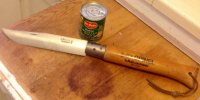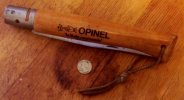Because I have to deal with this in my work all the time and understand that "performance testing" that generate "results" have to be done in a larger context to be meaningful.
Testing supports product (or design) evaluation.
Product evaluations support documented use cases or scenarios.
If we can settle on a use case or scenario, we can decide on a set of evaluation criteria for that use case. Some of these criteria will be
quantitative in nature. Others will be
qualitative. Some of quantitatively criteria can be handled with tests that generate quantitative "results" which may or may not be directly related to the performance criteria (e.g. rope cutting vs abrasion resistance). The importance or relevance of any given test to another use case and supporting set of performance criteria is unpredictable.
The Opinel is a pocket knife made for farming (with significant overlap with backpacking/camping, where it has good success). This is the use case that the knife should be evaluated against. You will notice I didn't say EDC. This is because there is no good agreement on what EDC means and because what people carry daily starts to get us into the realm of personal self-definition through consumer product choices, a purely marketing concern (i.e. what does my knife say about me?).
I'm a work and don't have the time to provide a more detailed list of evaluation criteria for a farming/backpacking knife. This basic outline would need to be taken another level deeper or more I've not thought much about this as it's my lunch hour:
CUTTING
+ Wood cutting performance
+ Cordage and cardboard performance
+ Vegetable cutting
+ Meat and game
DURABILITY
+ Withstand repeated strong cutting forces
+ Withstand repeated strong lateral forces
+ Withstand repeated strong torsional forces
+ Durability of handle materials (crushing, being dropped, tool box damage)
+ Functionality of joint/lock when fouled with dirt, sand, etc.
+ Ability to resist edge chipping
+ Ability to retain a sharp edge
USABILITY
+ Ability to washed
+ Grip when wet
+ Torsional grip
+ Handle comfort during repeated heavy cutting
+ Pocket carry (weight, size, clip or no clip)
+ Ability to be sharpened in the field
There are many ways to consider different designs or products against a set of performance criteria. A common one is the "balanced score card". A good example of a balanced score card is the Consumer Reports used cars report. A list of criteria all presented on a visual 5 point scale. Another approach is a structured report or evaluation rubric.
This thread has been hijacked. The original question was about the loyal following of the Opinel. In my experience, to understand the appeal of the Opinel one has to consider it against other knives suitability for the farming/backpacking use case and consider the alternatives against set of criteria something like or derived from what I wrote above. If you do, then the Opinel fares well, despite it's low cost. Instead, we are now talking about the efficacy of rope cutting to determine edge retention. It's one tiny aspect of the larger picture.
A word about market requirements, as opposed to functional requirements. It is the world of market requirements where we get into why people buy what they buy and the marketing reality that people buy consumer products mostly to satisfy emotional "needs". Three of the deepest held emotional, pre-rational and almost religious beliefs in the US regarding consumer products of all sorts are a) BEST can determined through object performance criteria (e.g. faster, lighter, stronger, harder), b) PRICE correlates to function, and c) NEW is always better than old. The first leads to the deeply held belief in metrics, quantification and statistics. The second leads to the game that can be played with pricing strategies like the premium pricing strategy. The third leads to an incorrect dismissal of solid engineering done by our elders.
I mention the problems of market requirements to wrap back to your request for me to develop my test. Your desire for objective testing is a part of a larger cultural bias for objective testing as a way to justify and understand purchasing decisions. This is true regardless of and often in spite of performance criteria that actually matter. Here's an example from the cycling world. Obviously, lighter is better for bikes, right? Enter the world of the "weight weenies". They even have their own web site.
http://weightweenies.starbike.com/
Question: Why do weight weenies ride lighter bikes than the Tour de France winner? Or better, why is that the bike that won the TdF isn't the lightest bike made?
Answer: For exactly the same reason why the Boye Boat knife isn't the best farming/backpacking knife despite the fact that it would have a good shot at being at the very top of Ankerson's rope cutting test.
This is the fallacy of relying on repeatable tests that generate numeric "results". They're a lazy excuse for actual product evaluation and play into our cultural belief in objective, numerical truth.


